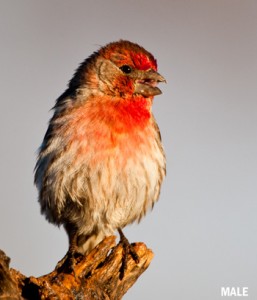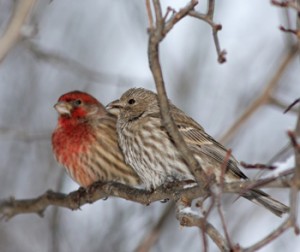 Habits
Habits
The House Finch has a beautiful song and can often be heard singing. It is a suburban bird and has adjusted well to living among humans. In fact, it’ll often nest in hanging baskets. It will come to nearly any type of feeder as well.
 Nesting
Nesting
House Finch eggs are small and pale blue and are laid in a loose cup of assorted materials including grass, string, feathers and other items it scavenges in yards. The brood of two to six nestlings will fledge in 11-20 days. So, if you find a pair happily raising a family in your hanging basket, just be patient and you’ll be rewarded with more beautifully singing birds in your yard. House Finches may have as many as three broods a year with both parents frantically caring for the young.
Range
While they were originally found in the Southwest and Mexico, in the 1940s several were released on Long Island and they’ve since spread throughout much of the nation. In the colder regions of the country, the birds will migrate to a slightly warmer climate for a short period of time. They’re often found in Minnesota through December and then return in March.
Diet
They eat seeds, fruit and some insects, and will visit nearly any type of feeder. Interesting fact: the diet of the male House Finch determines the vibrancy of its redness. Brighter red birds have a better chance of finding a mate than duller or orange-cast birds.
Conjunctivitis
House Finches are highly susceptible to conjunctivitis. The disease will cause inflammation leading to blindness. It is not curable and is highly contagious to other birds. For many years, rehabilitators thought the disease was treatable, but studies have found that the disease merely goes into a remission stage and will flare during times of stress. The best way to prevent your House Finches from contracting it is to regularly clean your feeders and bath. If you find a bird with swollen eyes, take it to your nearest wildlife rehabilitation center. In Minnesota, WRC is located on Dale St., in Roseville.

